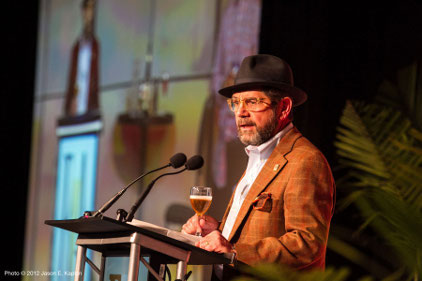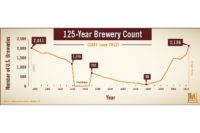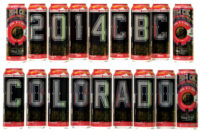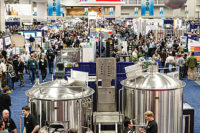With more than 4,500 attendees from 35 countries, the Craft Brewers Conference & BrewExpo America, hosted by the Brewers Association, Boulder, Colo., May 2-5 in San Diego, was a testament to the growth in the industry. Setting the tone for the event, Brewers Association President Charlie Papazian addressed any doubts about the industry’s potential, saying, “We are not in a bubble, we are knee-deep in foam — and the foam is still rising.”
Confirming that the U.S. beer industry is currently in “historic beer times because of craft beer,” Brewers Association Director Paul Gatza provided his annual State of the Craft Brewing Industry speech during the May 3 general session. Noting that the industry currently is home to more than 13,000 beer labels, he queried whether another industry exists in which customers and marketers are more connected than the beer industry. Data reported in the State of the Craft Brewing Industry presentation is based on the Brewers Association’s survey of its members, which this year garnered a 90 percent return rate.
In 2011, craft beer continued to be the story in the U.S. brewing industry, Gatza said. As craft beer grows, the economy has not yet bounced back, and wine and spirits have taken some of beer’s share. MillerCoors and Anheuser-Busch have lost 12.2 million barrels in volume during the last two years, he reported. He suggested that large brewers have lost connection with consumers, some of which is being captured by imported beers, which experienced an uptick in 2011. Last year also saw fewer acquisitions in the craft brewing space, Gatza noted, but continued consolidation at the wholesaler level was reported, including expansion of brewery-owned distributors.
During the last four years, craft beer barrel production increased 44 percent growing from 10.1 to 11.5 million barrels, he explained. Overall, craft brewers’ volume grew 13 percent, selling 11.5 million barrels in 2011, according to data from the Brewers Association. Pricing increased 1.2 percent during the time period, Gatza said. Brewers Association data shows 250 brewery openings, which is the most since 1997 and represents a 30 percent increase from 2010 and twice the amount from 2009, he noted. In addition, it reported 76 brewpub openings and 25 closings, and 915 breweries in planning in 2011, a figure that had increased to 1,119 by early May, he noted.
The brewpub segment reported a 5.6 percent increase and, Gatza noted, represents the most openings on record since 2000 and the fewest closings since 1996. Also forging new territory, the microbrewery segment reported 174 openings and 12 closings, surpassing the previous record of 117 openings, Gatza said. The microbrewery segment increased 26.4 percent in 2011 with 11 microbreweries reporting enough growth to be considered regional breweries, he noted. If the growth of those 11 now-regional breweries was included, Gatza explained, the reported growth would total 35 percent.
Possibly fueling the segment’s growth is the consumer trend toward local products, he noted. With more consumers seeking products made in their area, Gatza suggested that could put the growing number of craft breweries in a “very sweet spot.” Nanobreweries also are fitting into this niche, he noted. Some of these newer breweries are not fitting the traditional definition of selling beer and are choosing instead to operate tasting rooms and sell take-away refillable growlers, he explained. The Brewers Association also has heard of craft brewers adding lodging to their offerings, including breweries with campgrounds, he said.
Also helping the segment’s growth is packaging, including canning, Gatza said. He specifically noted that beer releases in 16-ounce cans are fueling convenience store penetration for brands. Retailers also are experimenting with growler stations that allow consumers to bring in a refillable glass jug and choose from a selection of craft beers, he noted.
In terms of styles, Gatza reported that seasonal varieties take the top spot, but Benj Steinman, president at Beer Marketers Insights, presented data that India Pale Ales (IPAs) have become the No. 1-sellers. According to Steinman’s data, 2011 was the year of the IPA with 41 percent growth in measured channels through early 2012. Brewers Association data shows IPAs as second followed by pale ale, variety packs, amber ale, amber lager and wheat beers. Overall, Gatza noted that consumers are seeking different beer options and want variety in their refrigerators and coolers.
With consumer curiosity at an all-time high, Gatza emphasized to the brewers in the audience that quality should be their first priority because if a consumer tries a bad craft beer, they’re less likely to try another craft beer brand. The segment also is being challenged by releases that are affecting retail placements both on- and off-premise and blur the definition of beer, such as flavored malt beverages (FMBs), hard cider, and lemonade or shandy-style beers. Keynote speaker Steve Hindy of Brooklyn Brewery was more emphatic about these trends, emphasizing to the crowd to avoid temptation to join the FMB or hard cider bandwagons.
Growth prospects
Brewers Association’s Papazian solidified his forecast that craft beer will make up 10 percent of all beer sold in the United States by 2017, noting that the event’s 4,500 attendees are a testament to the prospect of achieving the market share. He also emphasized key touch-points for the industry that he summarizes under the acronym TISEE, which stands for technology, innovation, service, efficiency and education. These aspects are the fundamental areas of investment needed for sustainable growth of the craft brewing industry, Papazian says.
Technology addresses the operations and equipment needed for brewing, but Papazian also encouraged craft brewers to embrace new methods of design, promotion and marketing for products as well as the possibilities to streamline business operations. His use of the term “innovation” not only addresses new beers, he said, but encourages craft brewers to be creative and innovative in all areas, including brewing, distributing and creating relevant relationships. Person-to-person contact also is paramount and is addressed in Papazian’s service value. Similar to technology and innovation, service goes beyond the traditional definition to ensure that brewers work with retailers and beer drinkers to develop connections with their products. Papazian highlights that the unique value that craft brewers provide beer drinkers is that they are not simply in the business of making and selling beer.
Rounding out his growth values for the industry, Papazian noted that craft brewing is not an easy business to be in and recommended that brewers seek efficiency beyond state-of-the-art equipment and embrace the interrelated and interconnectedness shared by fellow craft brewers. Papazian’s final touch-point is education, which includes scientific and style information for beer drinkers, regulatory authorities, elected officials and brewery employees. Summarizing the industry’s upward trajectory, Papazian said craft beer is doing a lot of things right already to innovate and change the U.S. brewing industry, which he predicted will continue to change dramatically. He also toasted the crowd asking them to promise that their last glass of beer on the planet would be from a small, independent brewing business, which Papazian said is a promise to themselves and future generations.
Home brewer and craft brewing advocate U.S. Rep. Peter DeFazio of Oregon also addressed the general session crowd encouraging brewers to continue to increase exports of its beers, which were up 86 percent in 2011, according to Brewers Association data. As founder of the House Small Brewer’s Caucus, DeFazio reported that the caucus’ current membership includes 111 congressmen and challenged attendees to help the caucus grow to 200 members. He also rallied attendees to contact their local government representatives to gain support for House of Representatives legislation known as the Small BREW Act, which seeks to amend the Internal Revenue Code of 1986 to provide a reduced rate of excise tax on beer produced domestically by certain small producers. The bill was introduced in March 2011.
The Brewers Association also presented the following brewers with the respective awards: James Ottolini, St. Louis Brewery Inc., received the 2012 Russell Schehrer Award for Innovation in Craft Brewing; founders of Odell Brewing Co. Doug, Wynne and Corkie Odell took home the Brewers Association Recognition Award; and Tom McCormick, executive director of the California Craft Brewers Association, received the F.X. Matt Defense of the Industry Award.
Industry insight
At the May 3 Beer Buyers Panel discussion, representatives from Meijer, Whole Foods, ABC Fine Wine & Spirits and Cost Plus World Market discussed their preferences for partnering with new brands in a conversation led by Jeff Nowicki of Bump Williams Consulting. The buyers admitted looking for buzz-worthy releases and providing a variety of choices to their shoppers. Although each market has its own niches, the buyers recommended exclusive retail placements, pumpkin beers and glass packaging, as many consumers have yet to gravitate to cans if glass is provided as an option at the shelf.
Beer Marketer’s Insights’ Steinman investigated whether we’re entering craft’s golden era during a May 4 educational session. He noted that some brands, such as Pabst Blue Ribbon, and categories within the beer industry might be riding craft’s coattails. In craft beer’s top-selling markets, which are Portland, Ore., the Seattle/Tacoma, Wash.-area, and the San Francisco/Oakland, Calif.-area, Steinman’s data showed that Anheuser-Busch and MillerCoors each have a market share in the low 20 point range, and that in those areas, craft grew at least a dollar share in 2011. However, Steinman noted that the big two brewers are changing up their games in response to craft’s growth.
He cautioned brewers to maintain their sense of community as they continue to ride the upward trajectory of craft beer. Additional causes for concern that Steinman highlighted were the slowing or decline of some of the larger craft brewers and their brands, the amount of new entries in the category and increased competition from the largest domestic brewers. Yet, he emphasized that the U.S. craft brewing movement has had global influence through imports as well as inspired craft brewery openings in other countries. BI



